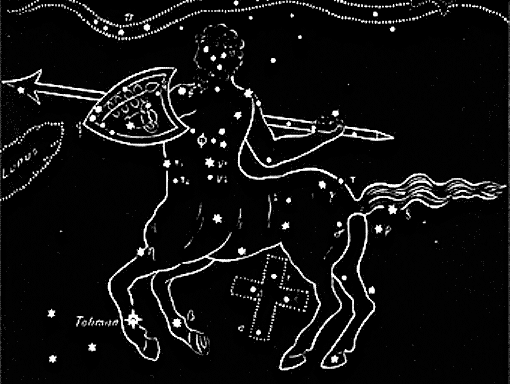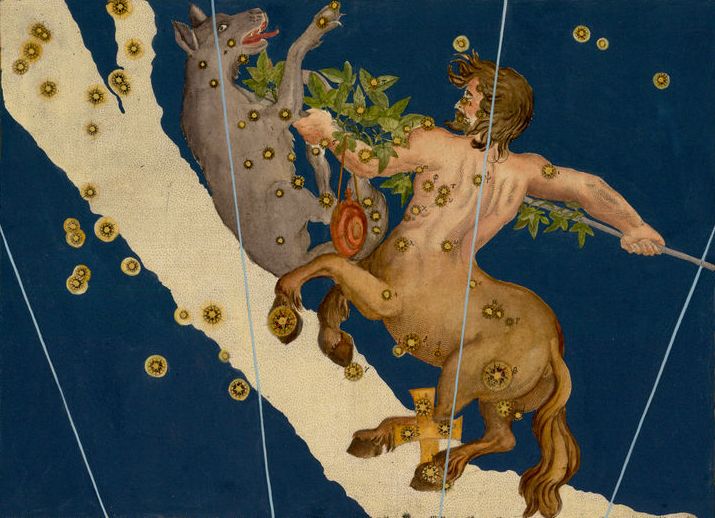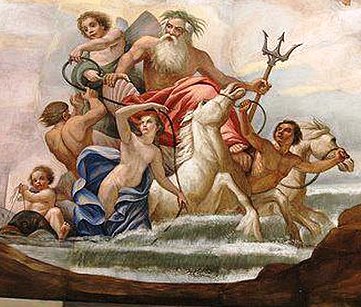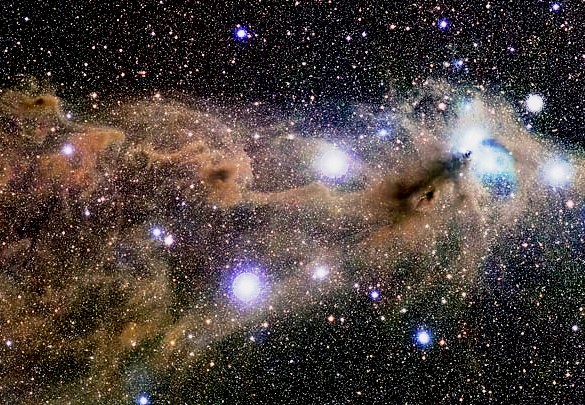Eddic Astronomy
by Dr. Christopher Johnsen
© 2014

[HOME]
The Spear and Ale Hero:
Geirvandill/Ölvaldi/Ivaldi
It is believed that horse-training and horseback riding first developed in the Eurasian Steppes around 3,000 B.C., as a response to the demands of cattle herding. A mounted horseman was able to cover a much greater amount of ground than a man on foot alone could, and this would enhance the herder’s ability to manage his animals. Cattle are not always disposed to do as the herder wants, and there was an implement that was essential to cow herding that every herder had to have possessed: a goad or spear.
A goad is a sharp, pointed stick used for driving oxen. It comes from the Indo-European root *ghei 'To propel, prick'. Its derivatives are: goad (from Old English gad, goad, from Germanic *gaido, goad, spear). Indo-European root *ghaiso- 'A stick, spear'. Derivatives: gore (to pierce or stab), garlic (from Old English gar, spear, Old Norse geirr, also in personal names). Latin hasta, translated 'spear', is related to gad, a goad. Sanskrit has the word hasta, meaning 'hand'. Sanskrit hasta 'hand' is related to the chiro- root from *ghes- 'Hand' [Chamber’s Dictionary of Etymology].
The alternate name Geirvandill or “the one occupied with the spear,” for the Norse myth character, Ölvaldi, shows his primary relationship to the spear and suggests he was known as the “spear hero” of the Teutonic myths. His name Ölvaldi, indicates a relationship to intoxicants as the “Öl-“ prefix suggests at the beginning of his name, indicating “ale” or the one “mighty in ale.” The two together; the combination of the knowledge of intoxicants and the use of a spear, would suggest that this named person would have knowledge of poisons and intoxicants and ways that these could be applied to spears or other missiles – a sort of wilderness shaman and expert on the use of poison spears and intoxicants.
The very same type of character is present in the Greek mythology - the centaur Chiron, who was knowledgeable in the preparation of intoxicants and is also a centaur (from cent – “goad” and “Taurus” – “bull” - “bull goad”). The son of Chronos and the ocean nymph Philyra, who was changed after his birth into a Linden tree, Chiron was a tutor to many young gods and heroes in Greek mythology who came to study with him on Mount Pelion (“Muddy Mountain”). The Centaurs skills in training and taming wild horses might relate to Chiron's duty as a tutor, taming his young students’ wild spirits.

The astral representation of Chiron is said to be Centaurus where he is portrayed as stabbing a wolf with his spear, which is supposed to be sacrificing a wild beast and presenting it to the gods on the altar, the constellation Ara. Would this not then be an appropriate constellation to represent Ölvaldi, whose half horse and half human appearance illustrates the liminal aspect of his character, halfway between beastial/primal mind and refined consciousness. In the early days of creation, he was an ally of the gods, and so were his sons. He also made gifts for the gods and presented them like a sacrifice.
Centaurus represents the Centaurs who were a tribe of half-man, half-horse savages, living on the mountains of Thessaly. They were people who tamed horses and are depicted as having the torso of a human and the body of a horse. A man on horseback at a distance would resemble this half man, half horse figure.
 |
Centaurs, like cowboys, would round up cattle and cowboys were also known as “cowpokes” which would described their job of herding cattle by goading or pricking them. Thessaly, which is in east-central Greece, was renowned for its cavalry and Poseidon was said to have made the first horse with his trident striking the ground in Thessaly (Virgil, Georgics, i. 12). The Centaurs had a problem with manners (related to Latin manus, hand) and one example shows appalling manners; when invited to a wedding they got drunk assaulted the female guests, and tried to take away the bride.
Centaurs, in Greek Mythology came to be when Ixion fell in love with the goddess Hera and tried to rape her. She escaped but told Zeus, who made a cloud resembling Hera and named it Nephele. He laid it beside Ixion (Ixion’s wheel is Corona Australis) and when Ixion let it be known that he had slept with Hera, Zeus had him strapped to a wheel, and whirled through the air. Nephele, the cloud, gave birth to Centaurus.
 |
“Their appearance gave their
name to the Centaurs, that is, a man combined with a horse. Some say
that they were horsemen of Thessaly, but because, as they rushed into
battle, the horses and men seemed to have one body, they maintained the
fiction of the Centaurs” [The Etymologies of Isidore of Seville, 7th
century AD, p.246.]
Centaurus is also in the region of the sky next to the Milky Way on the evil end near Scorpius and Sagitarius, indicating Ölvaldi’s connection to the mead and also his alliance with the evil powers of frost.
Rydberg says “Svigdir-Ivaldi in the mythic saga concerning the race-heroes was the first ruler of the Swedes, just as his sons, Völund and Egil, became those of the Longobardians and Slagfinn that of the Burgundians, and, as shall be shown below, also that of the Saxons.” (Teutonic Mythology)
In his essay, The Cult of Freyr and Freyja (William P. Reaves, 2008), William says that “Freyr himself is said to be the “boldest of riders.” (Lokasenna 37)” and that his worship involved rituals that used the horse either as a sacrifice or in fertility rituals. His horse was named Blóðughófa, “Bloody-hoof” and it would be supposed that Frey learned these skills of horsemanship from the elf princes he was raised with in Alfheim, who were also skilled in riding horses and horsemanship.
In the Teutonic weapon-myth the foremost representatives of the spear, the bow, and the sword are grandfather, father, and son and are respectively Ivaldi (spear hero), his son Örvandil-Egil (bow hero) and his grandson, Svipdag (sword hero). According to Rydberg, in the heroic poem, “Valtarius Manufortis,” written by Eckehard before 950, some features of the Ivaldi-myth have been preserved.
“Clad in an armour smithied by Völund (Vuelandia fabrica), Valtarius appears as the great spear-champion, who despises all other weapons of attack —and he has developed the use of the spear into an art, all of whose secrets were originally known by him alone, then also by Hagano, who learned them from the former. Thidreks Saga af Bern speaks of Valthari as an excellent spear-champion. Sure of success, he wagers his head in a competitive contest with this weapon.”
Ivaldi is in the oldest in his clan and his characteristics would seem to harken back to the oldest representatives of his race’s activities, and cattle herding was one of the most ancient. Accordingly, the essential tool of the cattle herder, whether for herding Aurochs or herding reindeer, was a long pointed stick, and that was his tool. Along with the stick would be the inherited knowledge of all the ways to use a stick like it domestically and also for battle.
Centaurus seems to have the right mix of spear wielding horseman/herder with sacrificer to the gods and his vicinity to the Milky Way also suggests the connection with Ivaldi and the cosmic mead. There is much more to say about Ivaldi, especially his connection to the moon and the rest of the mead myth, however, before I get into that, I plan on examining the Teutonic Club Hero, the Bow Hero and the Sword Hero and also how Thor’s hammer changed from stone to metal.